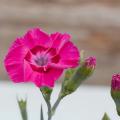Border Pinks 'Bath's Pink' {flat of 12 Pots - quarts}
|
|
Dianthus gratianopolitanus 'Bath's Pink' (AKA Cheddar Pinks)
Pronunciation: dy-AN-thus grah-shee-ah-noh-poh-LIT-an-us BATHS PINK
Product: 1161
Product: 1161
Shipping description: This product can be shipped to all 48 continental states
FREE SHIPPING!
1-9 flats of 12 quarts: $143.64 ($11.97 per plant)
10-99 flats: $136.46 per flat ($11.37 per plant)
100+ flats: $129.28 per flat ($10.77 per plant)
1-9 flats of 12 quarts: $143.64 ($11.97 per plant)
10-99 flats: $136.46 per flat ($11.37 per plant)
100+ flats: $129.28 per flat ($10.77 per plant)
In stock.
| (minimum of 1) flat of 12 Pots - quarts [ How many plants do I need? ] |
|||
|
|||
Also available as:
- Border Pinks 'Bath's Pink' {1-Gallon pot}
$28.97 or less
Out of stock. Expected date unknown. Email when available - Border Pinks 'Bath's Pink' {3 1/2 in. Pots min 25}
$9.57 or less
Out of stock. Expected 03/02/2026. Email when available
 (0)
(0) Full sun
Full sun  Part sun
Part sun














